2014 CHRYSLER 300 radiator cap
[x] Cancel search: radiator capPage 484 of 615
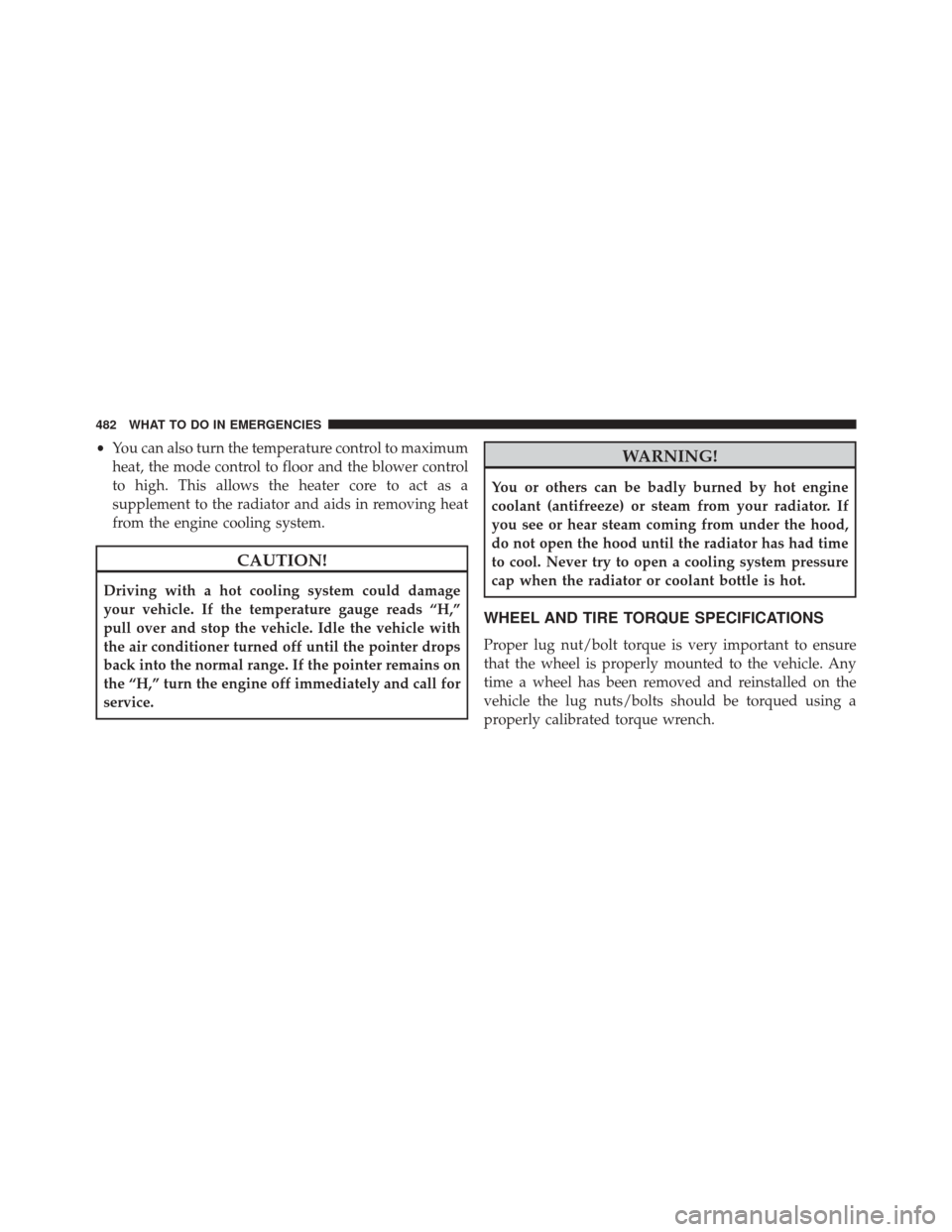
•You can also turn the temperature control to maximum
heat, the mode control to floor and the blower control
to high. This allows the heater core to act as a
supplement to the radiator and aids in removing heat
from the engine cooling system.
CAUTION!
Driving with a hot cooling system could damage
your vehicle. If the temperature gauge reads “H,”
pull over and stop the vehicle. Idle the vehicle with
the air conditioner turned off until the pointer drops
back into the normal range. If the pointer remains on
the “H,” turn the engine off immediately and call for
service.
WARNING!
You or others can be badly burned by hot engine
coolant (antifreeze) or steam from your radiator. If
you see or hear steam coming from under the hood,
do not open the hood until the radiator has had time
to cool. Never try to open a cooling system pressure
cap when the radiator or coolant bottle is hot.
WHEEL AND TIRE TORQUE SPECIFICATIONS
Proper lug nut/bolt torque is very important to ensure
that the wheel is properly mounted to the vehicle. Any
time a wheel has been removed and reinstalled on the
vehicle the lug nuts/bolts should be torqued using a
properly calibrated torque wrench.
482 WHAT TO DO IN EMERGENCIES
Page 532 of 615
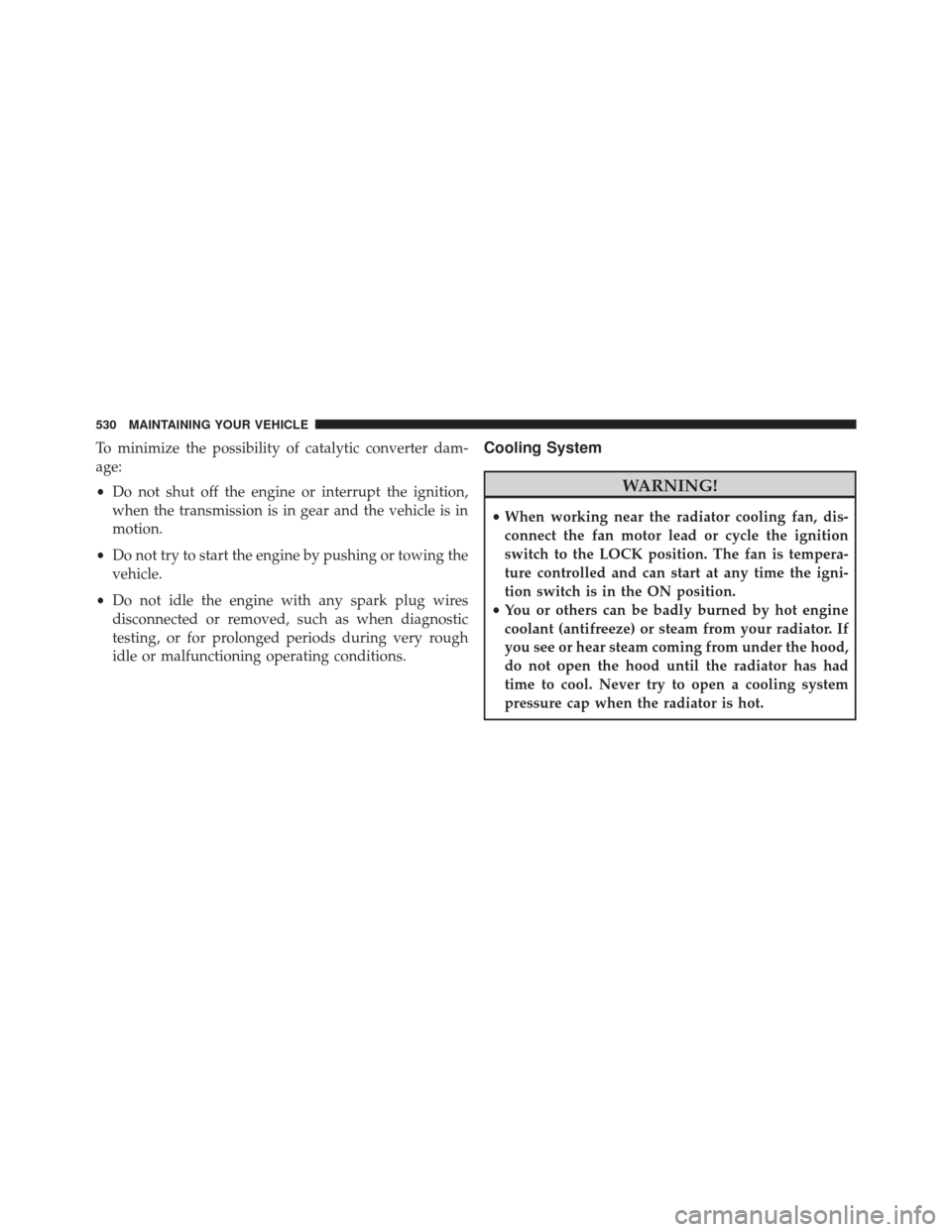
To minimize the possibility of catalytic converter dam-
age:
•Do not shut off the engine or interrupt the ignition,
when the transmission is in gear and the vehicle is in
motion.
• Do not try to start the engine by pushing or towing the
vehicle.
• Do not idle the engine with any spark plug wires
disconnected or removed, such as when diagnostic
testing, or for prolonged periods during very rough
idle or malfunctioning operating conditions.Cooling System
WARNING!
• When working near the radiator cooling fan, dis-
connect the fan motor lead or cycle the ignition
switch to the LOCK position. The fan is tempera-
ture controlled and can start at any time the igni-
tion switch is in the ON position.
• You or others can be badly burned by hot engine
coolant (antifreeze) or steam from your radiator. If
you see or hear steam coming from under the hood,
do not open the hood until the radiator has had
time to cool. Never try to open a cooling system
pressure cap when the radiator is hot.
530 MAINTAINING YOUR VEHICLE
Page 533 of 615
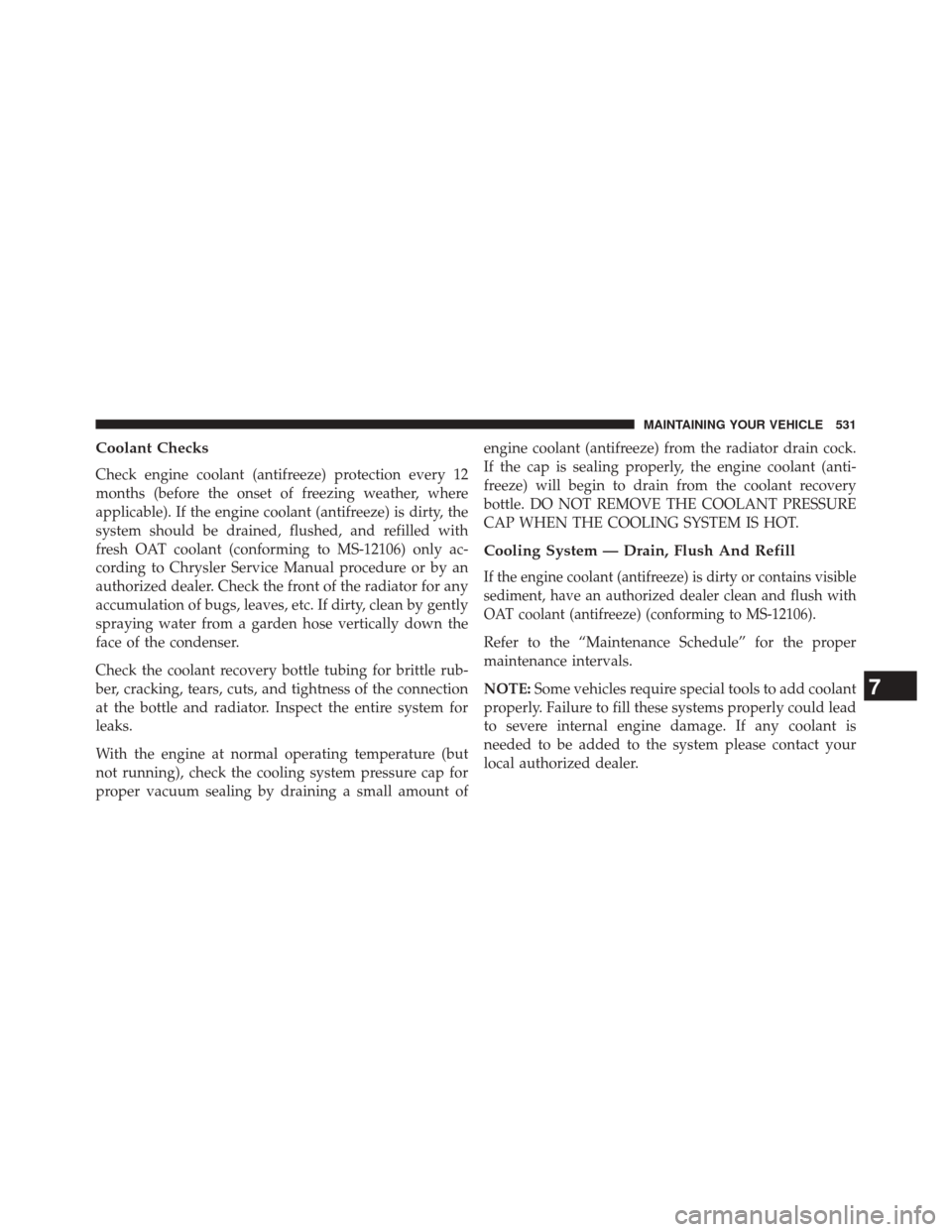
Coolant Checks
Check engine coolant (antifreeze) protection every 12
months (before the onset of freezing weather, where
applicable). If the engine coolant (antifreeze) is dirty, the
system should be drained, flushed, and refilled with
fresh OAT coolant (conforming to MS-12106) only ac-
cording to Chrysler Service Manual procedure or by an
authorized dealer. Check the front of the radiator for any
accumulation of bugs, leaves, etc. If dirty, clean by gently
spraying water from a garden hose vertically down the
face of the condenser.
Check the coolant recovery bottle tubing for brittle rub-
ber, cracking, tears, cuts, and tightness of the connection
at the bottle and radiator. Inspect the entire system for
leaks.
With the engine at normal operating temperature (but
not running), check the cooling system pressure cap for
proper vacuum sealing by draining a small amount ofengine coolant (antifreeze) from the radiator drain cock.
If the cap is sealing properly, the engine coolant (anti-
freeze) will begin to drain from the coolant recovery
bottle. DO NOT REMOVE THE COOLANT PRESSURE
CAP WHEN THE COOLING SYSTEM IS HOT.
Cooling System — Drain, Flush And Refill
If the engine coolant (antifreeze) is dirty or contains visible
sediment, have an authorized dealer clean and flush with
OAT coolant (antifreeze) (conforming to MS-12106).
Refer to the “Maintenance Schedule” for the proper
maintenance intervals.
NOTE:
Some vehicles require special tools to add coolant
properly. Failure to fill these systems properly could lead
to severe internal engine damage. If any coolant is
needed to be added to the system please contact your
local authorized dealer.
7
MAINTAINING YOUR VEHICLE 531
Page 536 of 615
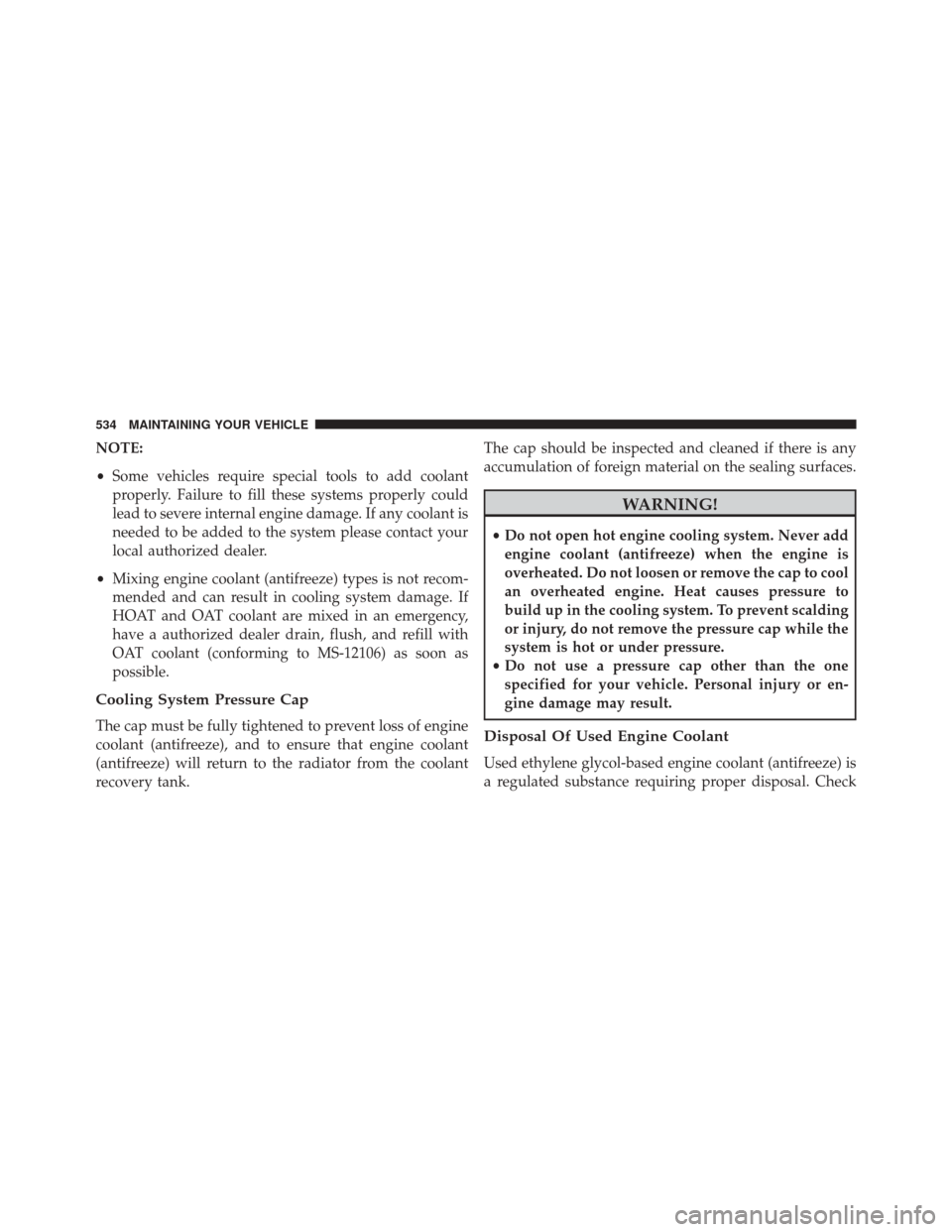
NOTE:
•Some vehicles require special tools to add coolant
properly. Failure to fill these systems properly could
lead to severe internal engine damage. If any coolant is
needed to be added to the system please contact your
local authorized dealer.
• Mixing engine coolant (antifreeze) types is not recom-
mended and can result in cooling system damage. If
HOAT and OAT coolant are mixed in an emergency,
have a authorized dealer drain, flush, and refill with
OAT coolant (conforming to MS-12106) as soon as
possible.
Cooling System Pressure Cap
The cap must be fully tightened to prevent loss of engine
coolant (antifreeze), and to ensure that engine coolant
(antifreeze) will return to the radiator from the coolant
recovery tank. The cap should be inspected and cleaned if there is any
accumulation of foreign material on the sealing surfaces.
WARNING!
•
Do not open hot engine cooling system. Never add
engine coolant (antifreeze) when the engine is
overheated. Do not loosen or remove the cap to cool
an overheated engine. Heat causes pressure to
build up in the cooling system. To prevent scalding
or injury, do not remove the pressure cap while the
system is hot or under pressure.
• Do not use a pressure cap other than the one
specified for your vehicle. Personal injury or en-
gine damage may result.
Disposal Of Used Engine Coolant
Used ethylene glycol-based engine coolant (antifreeze) is
a regulated substance requiring proper disposal. Check
534 MAINTAINING YOUR VEHICLE
Page 537 of 615
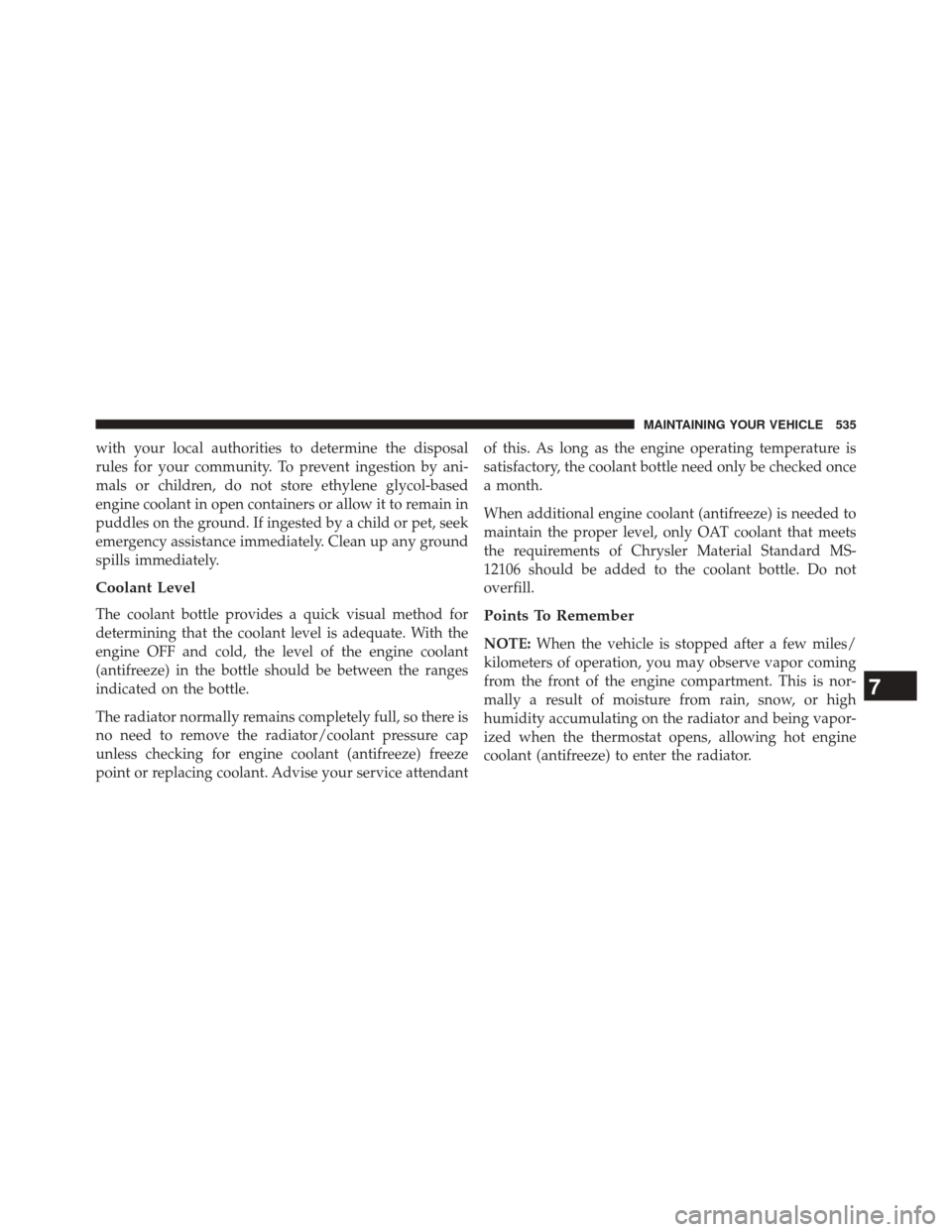
with your local authorities to determine the disposal
rules for your community. To prevent ingestion by ani-
mals or children, do not store ethylene glycol-based
engine coolant in open containers or allow it to remain in
puddles on the ground. If ingested by a child or pet, seek
emergency assistance immediately. Clean up any ground
spills immediately.
Coolant Level
The coolant bottle provides a quick visual method for
determining that the coolant level is adequate. With the
engine OFF and cold, the level of the engine coolant
(antifreeze) in the bottle should be between the ranges
indicated on the bottle.
The radiator normally remains completely full, so there is
no need to remove the radiator/coolant pressure cap
unless checking for engine coolant (antifreeze) freeze
point or replacing coolant. Advise your service attendantof this. As long as the engine operating temperature is
satisfactory, the coolant bottle need only be checked once
a month.
When additional engine coolant (antifreeze) is needed to
maintain the proper level, only OAT coolant that meets
the requirements of Chrysler Material Standard MS-
12106 should be added to the coolant bottle. Do not
overfill.Points To Remember
NOTE:
When the vehicle is stopped after a few miles/
kilometers of operation, you may observe vapor coming
from the front of the engine compartment. This is nor-
mally a result of moisture from rain, snow, or high
humidity accumulating on the radiator and being vapor-
ized when the thermostat opens, allowing hot engine
coolant (antifreeze) to enter the radiator.
7
MAINTAINING YOUR VEHICLE 535
Page 594 of 615
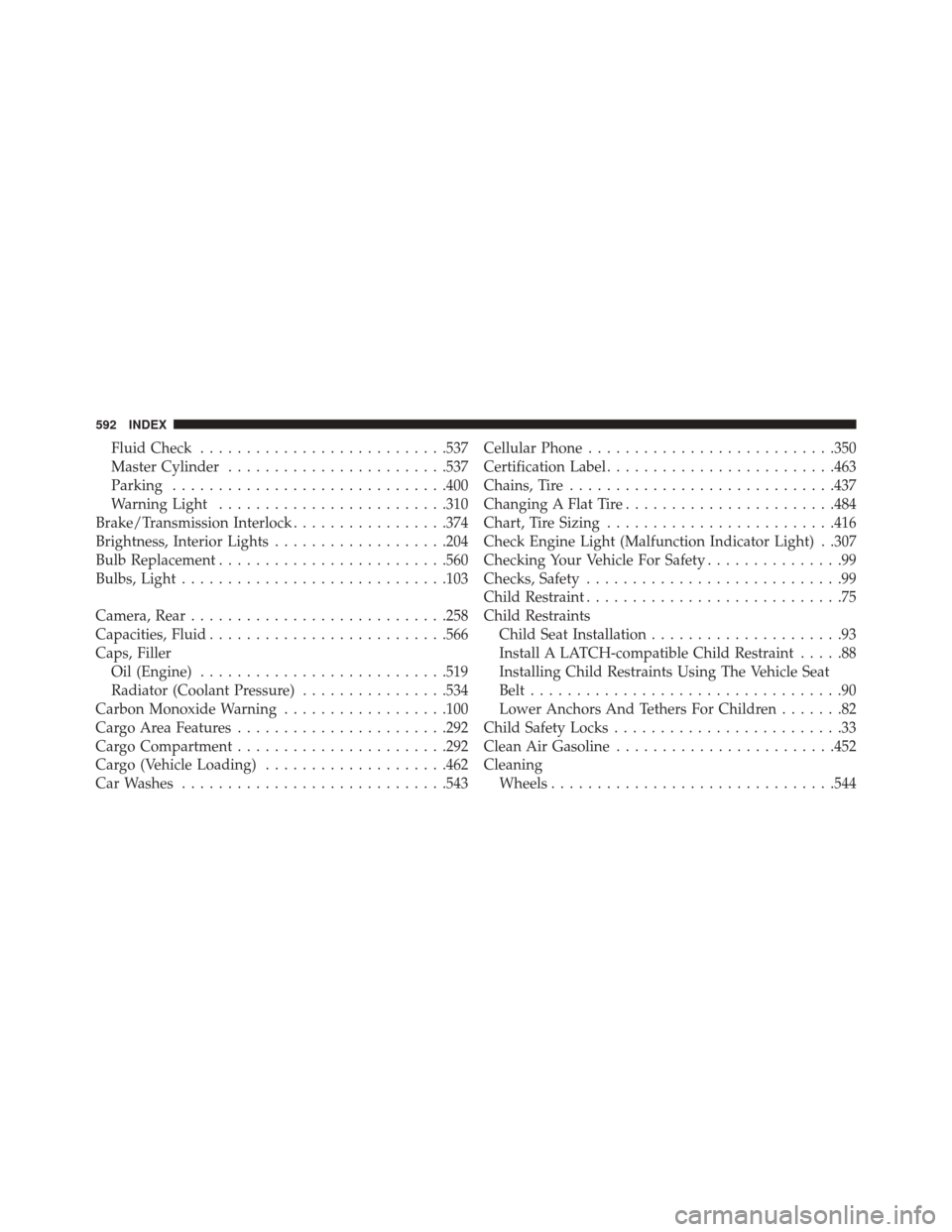
Fluid Check.......................... .537
Master Cylinder ....................... .537
Parking ............................. .400
Warning Light ........................ .310
Brake/Transmission Interlock .................374
Brightness, Interior Lights ...................204
Bulb Replacement ........................ .560
Bulbs, Light ............................ .103
Camera, Rear ........................... .258
Capacities, Fluid ......................... .566
Caps, Filler Oil (Engine) .......................... .519
Radiator (Coolant Pressure) ................534
Carbon Monoxide Warning ..................100
Cargo Area Features ...................... .292
Cargo Compartment ...................... .292
Cargo (Vehicle Loading) ....................462
Car Washes ............................ .543Cellular Phone
.......................... .350
Certification Label ........................ .463
Chains, Tire ............................ .437
Changing A Flat Tire ...................... .484
Chart, Tire Sizing ........................ .416
Check Engine Light (Malfunction Indicator Light) . .307
Checking Your Vehicle For Safety ...............99
Checks, Safety ............................99
Child Restraint ............................75
Child Restraints Child Seat Installation .....................93
Install A LATCH-compatible Child Restraint .....88
Installing Child Restraints Using The Vehicle Seat
Belt ..................................90
Lower Anchors And Tethers For Children .......82
Child Safety Locks .........................33
Clean Air Gasoline ....................... .452
Cleaning Wheels .............................. .544
592 INDEX
Page 595 of 615
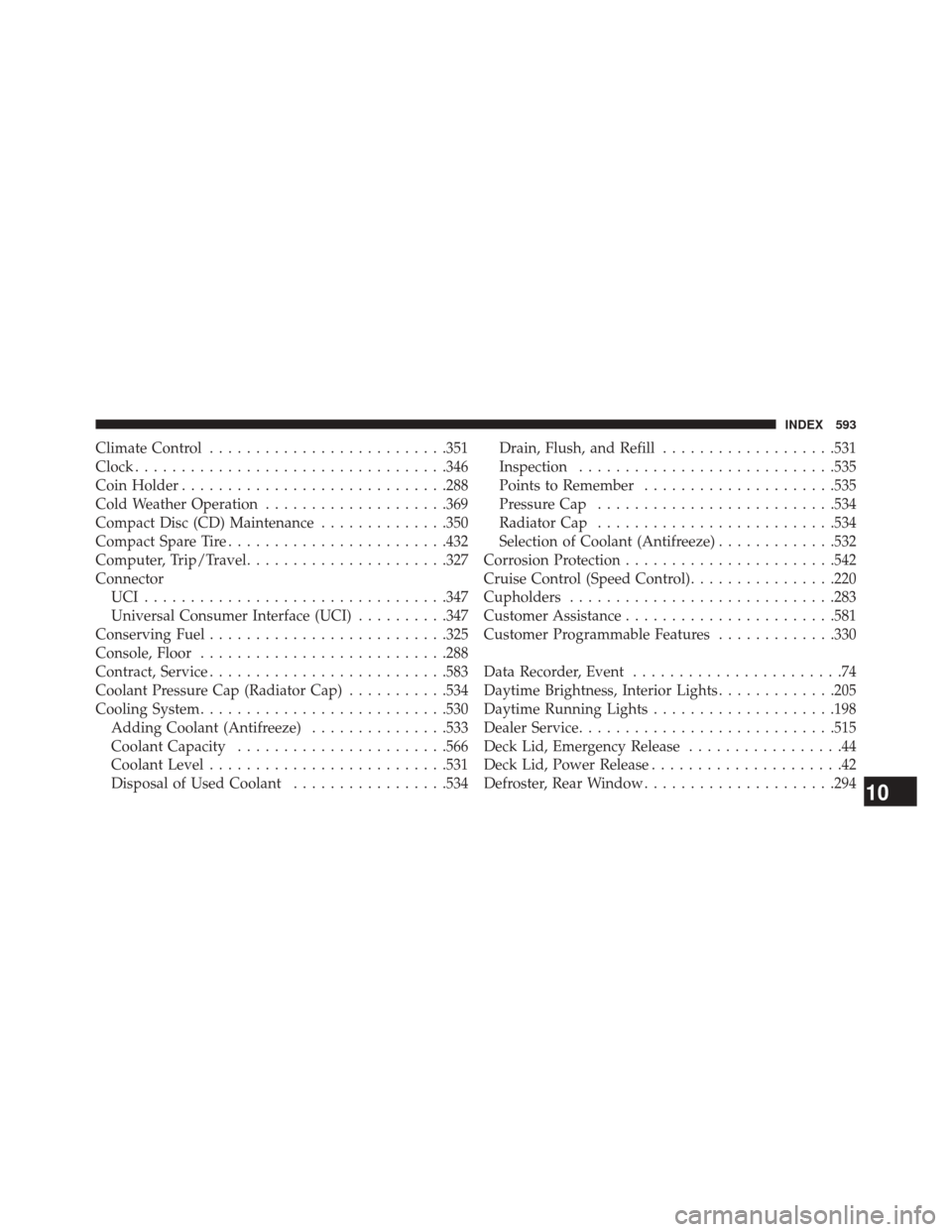
Climate Control......................... .351
Clock ................................. .346
Coin Holder ............................ .288
Cold Weather Operation ....................369
Compact Disc (CD) Maintenance ..............350
Compact Spare Tire ....................... .432
Computer, Trip/Travel ..................... .327
Connector UCI................................ .347
Universal Consumer Interface (UCI) ..........347
Conserving Fuel ......................... .325
Console, Floor .......................... .288
Contract, Service ......................... .583
Coolant Pressure Cap (Radiator Cap) ...........534
Cooling System .......................... .530
Adding Coolant (Antifreeze) ...............533
Coolant Capacity ...................... .566
Coolant Level ......................... .531
Disposal of Used Coolant .................534 Drain, Flush, and Refill
...................531
Inspection ........................... .535
Points to Remember .....................535
Pressure Cap ......................... .534
Radiator Cap ......................... .534
Selection of Coolant (Antifreeze) .............532
Corrosion Protection ...................... .542
Cruise Control (Speed Control) ................220
Cupholders ............................ .283
Customer Assistance ...................... .581
Customer Programmable Features .............330
Data Recorder, Event .......................74
Daytime Brightness, Interior Lights .............205
Daytime Running Lights ....................198
Dealer Service ........................... .515
Deck Lid, Emergency Release .................44
Deck Lid, Power Release .....................42
Defr
oster, Rear Window .....................294
10
INDEX 593
Page 606 of 615
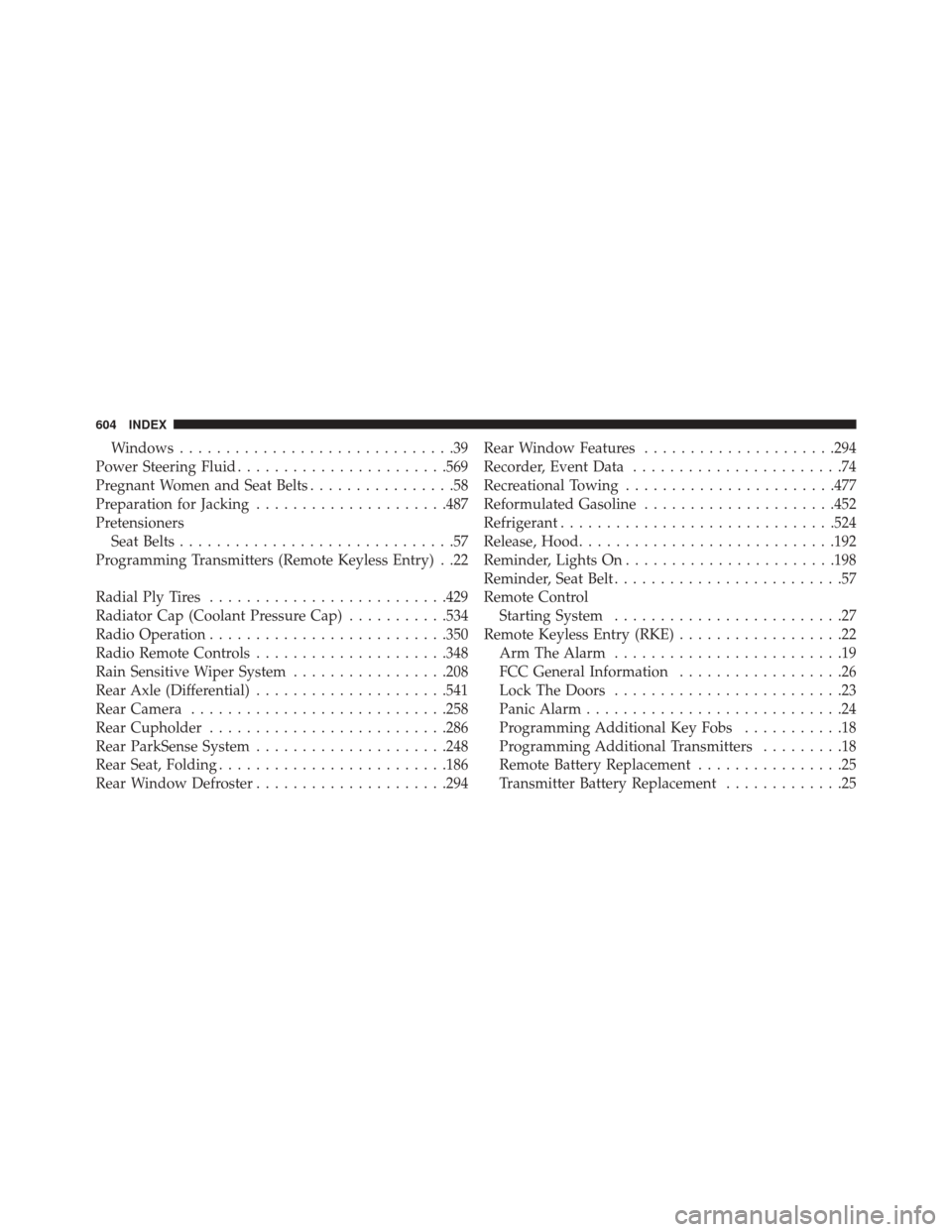
Windows..............................39
Power Steering Fluid ...................... .569
Pregnant Women and Seat Belts ................58
Preparation for Jacking .....................487
Pretensioners Seat Belts ..............................57
Programming Transmitters (Remote Keyless Entry) . .22
Radial Ply Tires ......................... .429
Radiator Cap (Coolant Pressure Cap) ...........534
Radio Operation ......................... .350
Radio Remote Controls .....................348
Rain Sensitive Wiper System .................208
Rear Axle (Differential) .....................541
Rear Camera ........................... .258
Rear Cupholder ......................... .286
Rear ParkSense System .....................248
Rear Seat, Folding ........................ .186
Rear Window Defroster .....................294 Rear Window Features
.....................294
Recorder, Event Data .......................74
Recreational Towing ...................... .477
Reformulated Gasoline .....................452
Refrigerant ............................. .524
Release, Hood ........................... .192
Reminder, Lights On ...................... .198
Reminder, Seat Belt .........................57
Remote Control Starting System .........................27
Remote Keyless Entry (RKE) ..................22
Arm The Alarm .........................19
FCC General Information ..................26
Lock The Doors .........................23
Panic Alarm ............................24
Programming Additional Key Fobs ...........18
Programming Additional Transmitters .........18
Remote Battery Replacement ................25
Transmitter Battery Replacement .............25
604 INDEX